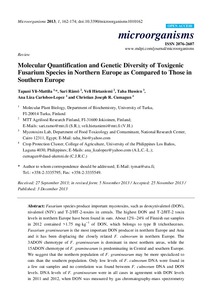Molecular Quantification and Genetic Diversity of Toxigenic Fusarium Species in Northern Europe as Compared to Those in Southern Europe
Taha Hussien; Christian Joseph R Cumagun; Ana Liza Carlobos-Lopez; Sari Rämö; Veli Hietaniemi; Tapani Yli-Mattila
https://urn.fi/URN:NBN:fi-fe2021042714620
Tiivistelmä
Fusarium species produce important mycotoxins, such as deoxynivalenol (DON), nivalenol (NIV) and T-2/HT-2-toxins in cereals. The highest DON and T-2/HT-2 toxin levels in northern Europe have been found in oats. About 12%–24% of Finnish oat samples in 2012 contained >1.75 mg·kg−1 of DON, which belongs to type B trichothecenes. Fusarium graminearum is the most important DON producer in northern Europe and Asia and it has been displacing the closely related F. culmorum in northern Europe. The 3ADON chemotype of F. graminearum is dominant in most northern areas, while the 15ADON chemotype of F. graminearum is predominating in Central and southern Europe. We suggest that the northern population of F. graminearum may be more specialized to oats than the southern population. Only low levels of F. culmorum DNA were found in
a few oat samples and no correlation was found between F. culmorum DNA and DON levels. DNA levels of F. graminearum were in all cases in agreement with DON levels
in 2011 and 2012, when DON was measured by gas chromatography-mass spectrometry (GC-MS). When the RIDA® QUICK SCAN kit results (DON) were compared to DNA levels of F. graminearum, the variation was much higher. The homogenization of the oats flour by grinding oats with 1 mm sieve seems to be connected to this variation. There was a significant correlation between the combined T-2 and HT-2 and the combined DNA levels of F. langsethiae and F. sporotrichioides in Finland in 2010–2012.
Keywords: Fusarium; mycotoxins; diversity; Europe; qPCR
Kokoelmat
- Rinnakkaistallenteet [19207]
